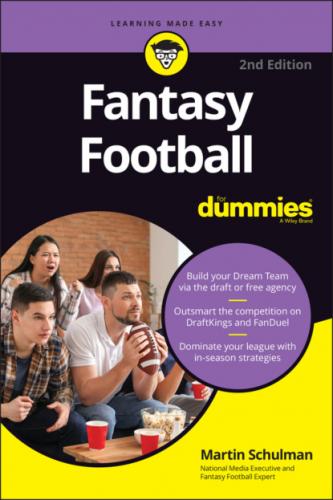Where to Go from Here
Like all For Dummies titles, this is a reference book, and each chapter is a modular piece about a specific area of fantasy football. You can skip around and not get lost! Flip to the table of contents or the index, find the location of what you want to know, read what you want to read, and feel free to skip the rest of the info.
If you’re totally new to the game, you can start your reading with Part 1. If you know the game but want to improve your skills as a fantasy coach, you may want to focus on Parts 2 and 3. If you already had your league’s draft, you may want to skip to Part 3, which discusses in-season game management. If you are here to learn how to master Daily Fantasy Sports play, then skip to Part 4!
From the day you first sign up for a fantasy league to the day you hoist your league’s championship trophy over your head to the day you sign up for another season, this book will be your guide through the world of fantasy football. No matter what you read, I wish you luck in your future fantasy adventures.
Part 1
The Xs and Os of Fantasy Football: Just the Basics, Please
IN THIS PART …
If you’re new to the game of fantasy football, Part I has you covered. Chapter 1 gives you the quick lowdown on fantasy football. In Chapter 2, I explain how fantasy points are scored and why scoring is so important to the game. Chapter 3 covers the types of leagues available to fantasy players and helps you determine which one to join, if you aren’t already in one. Finally, Chapter 4 helps prepare you for your fantasy draft so you can create a fantasy team that would make NFL general managers green with envy.
Chapter 1
The Reality of Fantasy Football: What’s It All About?
IN THIS CHAPTER
Sports fans usually root only for their favorite local teams, but fantasy sports allow the diehard sports fan to root for every team. In fact, playing fantasy makes watching every real game more fun and exciting. Millions of online fantasy sports enthusiasts can’t be wrong. The biggest of all the fantasy sports is fantasy football, and after you start playing, you’ll quickly know why. But before you start playing fantasy football, you need to know the basics.
This chapter gives you a quick overview of fantasy football. Consider this chapter your jumping off point into fantasy football. If you already know how to play but want to improve your game, feel free to skip to Chapter 4. However, if you keep reading, you may discover something about fantasy football that you didn’t know!
This chapter focuses on season-long fantasy football leagues, also known as ”standard” leagues. If you’re looking to play “Daily Fantasy Football” or “DFS,” these basics still apply, and the differences between the two is explained in more detail in Part 4.
Understanding Fantasy Football: A Quick Overview
What is fantasy football all about? Instead of just watching the NFL game, fantasy football allows you to feel like you’re part of the action by assembling an all-star lineup of the best players in the league. Fantasy allows you to imagine the fireworks of all those football stars playing as one unit. In this section, I give you a quick walkthrough of the basics of fantasy football so you can get a better grasp of this popular activity you’re considering playing.
How fantasy and the NFL differ
When comparing fantasy and the NFL, two significant differences stick out. In the NFL, all that matters is which team wins or loses. In fantasy, however, NFL wins and losses don’t count. Instead of team stats, fantasy relies not only on scored touchdowns but also on individual stats (such as yards gained) to calculate each fantasy player’s performance based on a determined league scoring system (see Chapter 2 for more on scoring). The results are called fantasy points, and your team’s fantasy point total is the sum of your starting players’ efforts. Your fantasy team will win or lose based on those results. So, in a way, fantasy football and the NFL both are about wins and losses that lead up to the best teams battling in a playoff format to decide a champion (see Chapter 12).
The other major difference is that fantasy teams consist of players from every team in the league, not just one NFL team (see the “Drafting the Right Players for Your Roster” section later in this chapter for a breakdown of a fantasy team roster). Only the best players are drafted; thus, each team is a sports fan’s fantasy. Everything else in the game tries to reflect and simulate real football.
How to play fantasy football
So, you’ve decided that you want to play fantasy football. Perhaps a buddy asked you to join a league, or maybe a coworker started talking trash and bet that he could easily beat you in a new league that he’s forming. Perhaps you don’t know anyone who plays, but you’re always hearing about fantasy football and you want to join a public league to find out what the fuss is all about.
